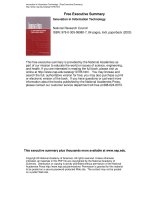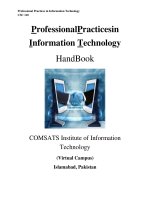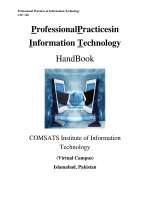Lecture Note Professional practices in information technology - Lecture No. 14: Ethics and Social Media
Bạn đang xem bản rút gọn của tài liệu. Xem và tải ngay bản đầy đủ của tài liệu tại đây (345.26 KB, 5 trang )
Professional Practices in Information Technology
CSC 110
ProfessionalPracticesin
Information Technology
HandBook
COMSATS Institute of Information
Technology
(Virtual Campus)
Islamabad, Pakistan
Professional Practices in Information Technology
CSC 110
Lecture 14
Ethics and Social Media
14.1 Privacy questions different to ’traditional’ issues
”Forgive and forget” does not exist anymore. What was once online, can be found always
(Blanchette & Johnson, 2002)
–
Obligation to protect the future privacy interests of children/teens? (Bülow & Wester,
2011)
–
Streisand effect (residence of the singer)
Concept of privacy changing
–
Everyone makes mistakes
–
No one is expected to be ’perfect’
Since what one has done is always available, one is expected to always be same?
Expectations of online privacy
Can we expect to not be known?
Writing to IRC, other chat, bulletin board or blog / newspaper comments section, expecting to be
‘anonymous’
–
Is a ‘nick’ with no identifying information some sort of guarantee for anonymity?
–
A lot of information available in many cases
–
Searches to identify etc
Internet ‘discussions’ not similar to physical discussions, anyone can log them and find the
information later
–
People generally think that they have more privacy than they actually do
–
Online monitoring, “spyware”—one generally does not know when one is
logged/monitored
Professional Practices in Information Technology
CSC 110
In (open) Blogs there can be no expectation of privacy – even if written with a ‘nick’
(Grodzinsky & Tavani, 2009)
Privacy in SoMes
Public and private blur – in SoMes it is difficult to control the audiences of one’s posts (see e.g.
Netchitailova, 2011 on Facebook).
Most people just do not bother, but the added illusion of anonymity promotes writing things one
would not divulge of one’s private life, say, in Blogs or similar.
Also, some groups (such as children and/or elderly – for different reasons) have undue trust to
hand over their private information to outsiders (See e.g. Chai et al., 2008).
Pictures in SoMes?
–
Does anyone ever ask whether the pictures they take can be published? Most often not.
(Parrish, 2010, Cammozzo, 2011.)
–
Typically, this not a problem, but what about, say the Arab Spring? How many have
actually been killed due to having been identified from pictures? (on Iranian elections of
2009 and the following riots, see Parrish, 2010. Also see Asai, 2011 on Tunisia and
Egypt.)
Children and young people
Children’s privacy
–
‘Funny pictures’ parents put on a SoMe may come to light – we know how cruel children
can be, and adults do not always think what they put on social media
–
Vlogging (Ahmed, 2011a) as an example of potential privacy harm for children.
–
Pictures/video breaching privacy can be uploaded easily enough – and distributed widely
(see e.g. Khan, 2008 amongst others).
Many younger users of SoMes are willing to trade a lot of their privacy for the (perceived) gains
offered by SoMes
–
They seem to be quite aware of the loss of privacy – and concerned.
Professional Practices in Information Technology
CSC 110
–
However, the perceived benefits override their concern for privacy; especially in the case
of ‘heavy users’. (Gumbus, Grodzinsky& Lilley, 2010.)
Property (immaterial)
Law
–
We know what the law states – or do we?
User Generated Content
–
Relation to commercial content
What is legal and what is right do not always meet
–
Basically all younger generation members have mixed or used copyright protected
materials illegally (or at least without permission)
–
Are we all criminals online? (Hielkema et al., unpublished)
Work
Workplace policies were primarily focused on email and Internet usage while at work. Now
SoMes need to be taken into account as well. Blurring of the line between work use and private
use
–
Laptops, corporate ’taxphones’ (multimedia devices), etc
For highend specialists – results what matters
–
So ’wasteoftime’ argument irrelevant, unless clearly a problem
Security question though; what work related info can be distributed in SoMes and what not?
Corporate image vs. private/professional image
Professionals need Internet presence – otherwise they do not exist in today’s work market…
–
Positive Internet presence – how to do this whilst avoiding ”Streisand effect”? Be careful
on what narrative bits you post in SoMes
–
’Professional brand’
(Gotterbarn, 2011, Mitra, 2011)
Professional Practices in Information Technology
CSC 110









